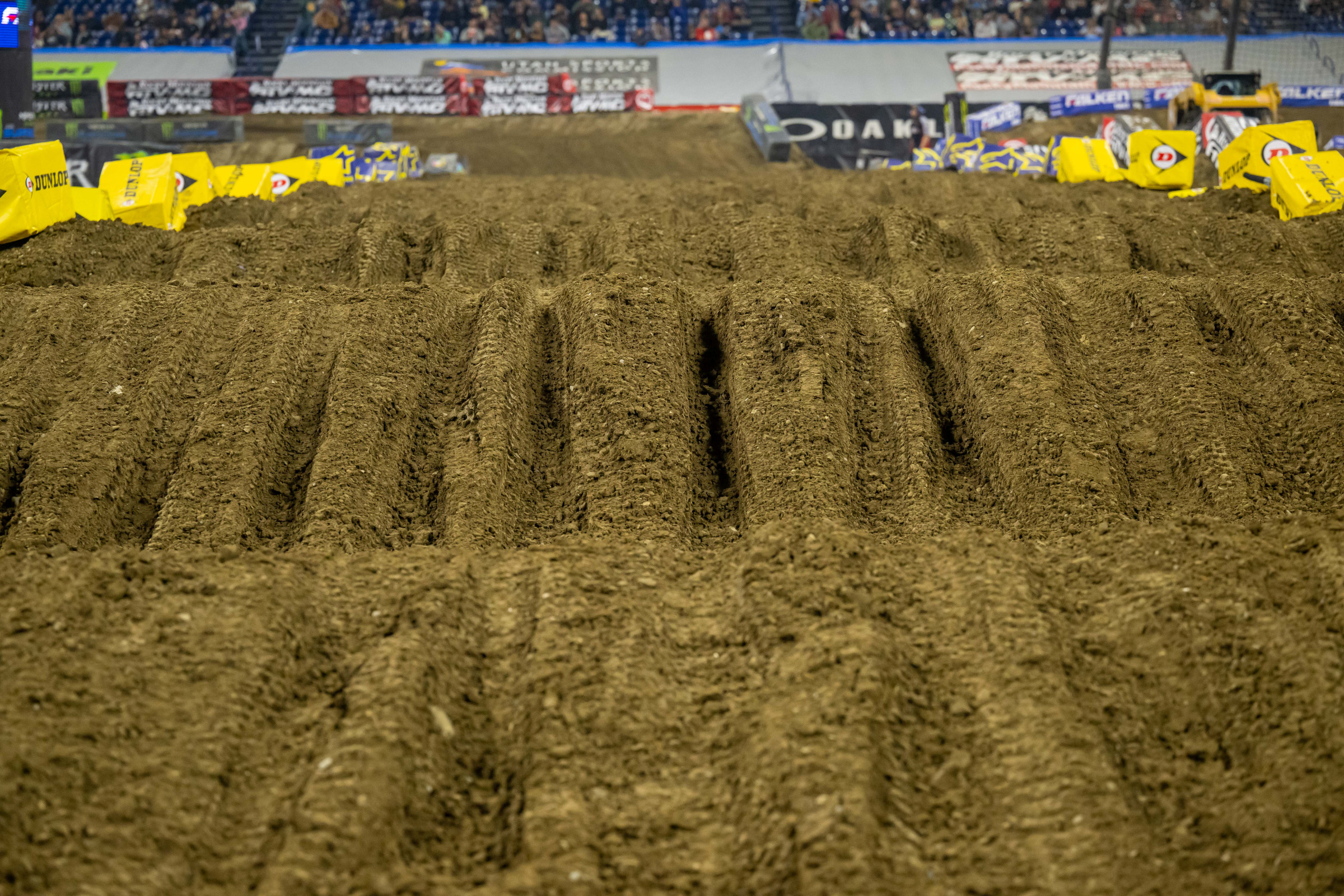The ninth round of Monster Energy AMA Supercross took place in Indianapolis on Saturday and, as usual, the action left us with plenty of questions. Good thing former pro and NBC reporter, Jason Thomas, is on staff and was able to give us a better understanding of the ins and outs of the Indianapolis Supercross.
The season entered the midpoint in Indianapolis. Is this something that affects the mindset of the racers at all? Did you detect a “hunker down,” kind of feeling in Indianapolis form anyone?
These rounds before an off weekend feel a little different. Everyone is ready for a breather after a couple of months of nonstop go-go-go. There’s a, ‘If I can just get through this weekend, I can regroup,” mentality. I always feel these races before a break are very important on a psychological level because the race result will last longer before an opportunity for more change. A good result sets up nicely for some R&R while a bad one simply stings longer.
The track looked insanely rutty. You were on the track, were the ruts indeed as gnarly as they looked?
Yes, it was a brutal main event. It’s funny, though, I was talking with Justin Cooper about the track and telling him how this track dynamic was very common 20-30 years ago. I would invite anyone to go back and watch footage from the '90s or early 2000s and see how rutty they were on the East Coast. It’s not as common nowadays so it becomes more of a storyline but once upon a time, this was just another Saturday night in the Midwest.
Speaking of ruts, they get deeper with every lap. How does a rider know when it’s time to switch ruts through a section?
This sounds dangerous but when riders drag footpegs, that’s the red line that can’t be crossed. The trouble is that this occurrence could be the one that sends them to the Alpinestars Mobile Medical Unit as well. The key is to stay vigilant as the track evolves so you’re ahead of the curve. It only takes one lap of being late to change to end your night.
Plenty of guys lost the front in the sand section. Even Cooper Webb crashed here in his heat race, and Chase Sexton went down in the main. It’s not like this is the first sand section these guys have ridden, what was it about this section that was so tricky?
The rollers and the never ending corner was a challenging combination. To carry momentum, riders have to stay over the back of the bike and let the front end float over the rollers. The problem is, when you keep your weight back, the front tire isn’t weighted. That can create the “push” and loss of traction. If the rollers weren’t there, riders would lean further forward and put more force on the front tire and create more grip. It’s a tricky ask to wheelie through rollers at an angle without losing front end traction.
Jett Reynolds put a huge block pass on Hunter Yoder in the 250SX West heat race, which resulted in both riders hitting the dirt. Should he have waited for the LCQ for a move like that? Do these two have beef we don’t know about?
That pass was way over the line, honestly. That wasn’t a block pass, that was a pick-up-pass. The odds of making that move without incident were virtually zero. I understand the urgency level with it being the last spot but when you take that angle, it’s premeditated and deliberate. I don’t know the exact protocol for warnings versus penalty, but I can tell you that my opinion is that this deserved more than a warning.
What a ride by Seth Hammaker, especially in the deep field of the 250SX East/West Showdown! He’s been riding well lately, but was there something extra he was doing in Indy that helped him get the win?
For one, the start was huge. When you look at how deep the field was, just avoiding the traffic and chaos of that was pivotal. He also remained patient and didn’t override the track which has been a tendency of his. It was apparent that the tutelage of Michael Byrne paid off here. Aggression isn’t always the best pathway, especially on a racetrack that harshly penalizes mistakes. This was a ride that Hammaker will want to rinse and repeat.
Julien Beaumer dislocated his shoulder in Arlington and didn’t ride until Indy. How tough is it mentally to keep from pushing it too hard when you’re racing with an injury like that?
It must have been unnerving to not know how his shoulder would respond. I was told his shoulder suffered a significant injury and much more than simply “banged up”. The question now becomes how do they approach this scenario if he does indeed need some sort of surgical repair. Do they hope for a critical mistake from Deegan even if he’s not able to fight him at 100 percent? Tough road to navigate here.
Take us through the incident with Justin Barcia and Aaron Plessinger when Barcia gave Plessinger’s front wheel a little love tap in a turn, which sent Plessinger to the ground. It didn’t look egregious, but Plessinger probably wasn’t delighted, either.
This was fairly benign as far as incidents go. AP’s strategy was to swing high early and then cut down underneath Bam Bam. This isn’t Bam’s first rodeo, though, and he saw this move coming. To prevent the cut down maneuver, all Barcia needed to do was simply pause and be in the line that AP wanted to use. The trouble is, AP is in a very precarious position and desperately needs Barcia to get out of the way before he falls down the berm. It’s a cheeky move by Barcia as he knows this and is pausing longer than needed to make life hard on Plessinger. The fact that both sides knew exactly what was happening is what makes it less than ideal. This was not high on the Barcia scale for aggression but AP ended up on the ground. That’s never much fun for practice partners.
Justin Cooper is notorious for jumping through the whoops, and the whoops were completely torn up in Indy. Did Cooper’s whoop jumping experience factor into his runner-up finish?
It absolutely did. Many other riders were torn between blitzing poorly and just committing to the jump method. Further, many riders who prefer to blitz don’t have the experience that both Webb and JC32 have in this arena. In a set of whoops where jumping is the best and most consistent method, they were the experts in the room and it showed
Were you surprised Sexton didn’t go after Webb in the first half of the race? He was only a few seconds behind him at one point, but was never able to close the gap.
I think he was trying! Webb’s line where he jumped over the wall went away after a few laps and Sexton started closing in. The trouble is, Sexton couldn’t decide what he wanted to do in the whoops. He tried to blitz, tried to jump, and tried a combination of both. Each time he tried something different, it meant it was an exploration and not perfectly executed. Webb had committed to jumping and had it locked in. His 3-3-3 was working and he was finding more and more efficiency within it. Let’s assume Sexton got it right two out of five laps. That’s a losing equation over the course of 20+ laps. When the track is deteriorating quickly, it's not the fastest route that can only be executed on a short term basis, it’s a repeatable approach that gives the best lap time over 20 minutes that will win out. It’s a hard equation to commit to but it is the winning one on a track like Indy.







